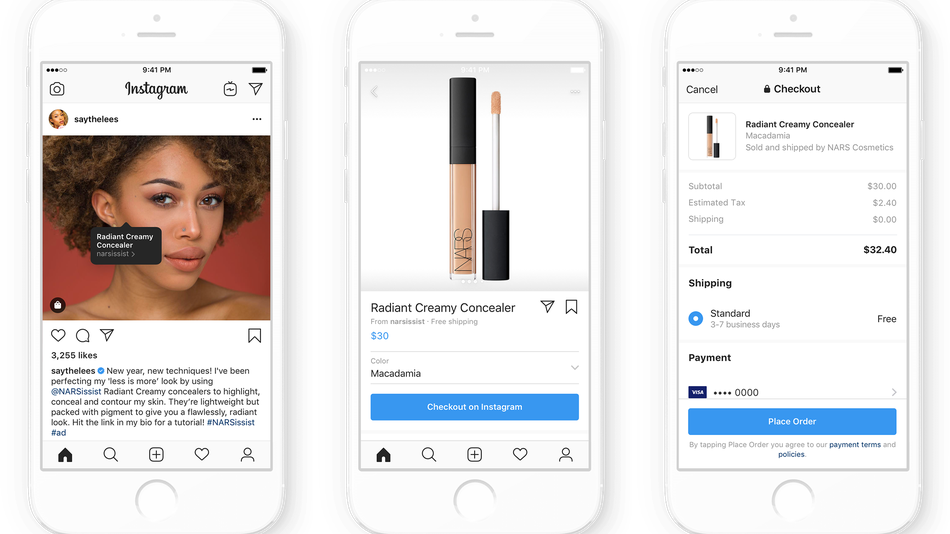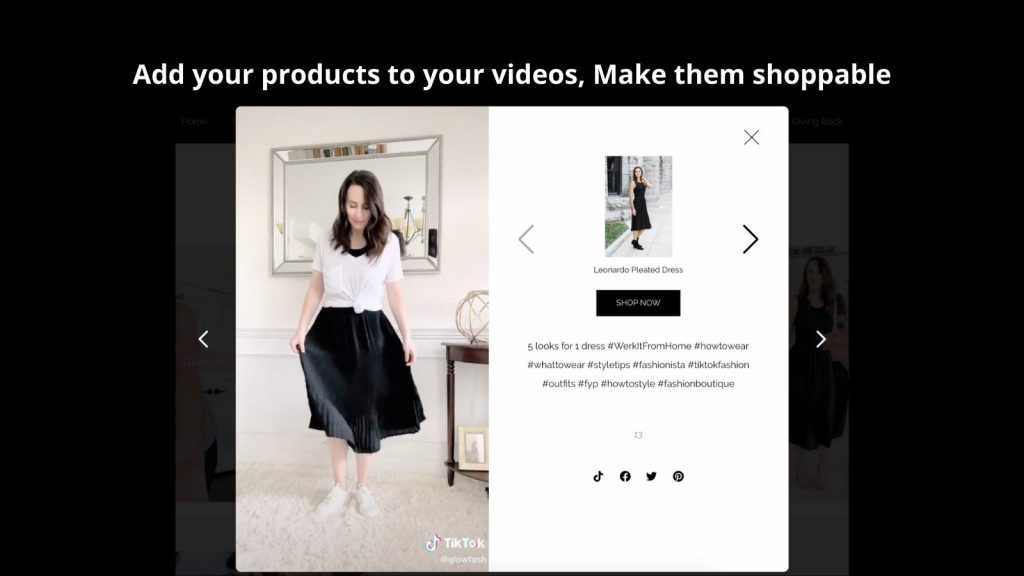The way people shop has changed dramatically in 2020. Over the last five years, there has been slow growth in ecommerce adoption amongst both brands and consumers. According to eMarketer social referral traffic to retail commerce sites grew 110% between 2019 and 2017 — the pandemic accelerated this trend big time. By some estimates, during the first three months of the pandemic, there was 10 years worth of ecommerce and digital adoption.
Overnight, social commerce became a necessity for consumers who had to get more creative about shopping — and the brands hoping to earn their business. In response to the increased demand, commerce-only platforms like Amazon have adopted social functionality, while social platforms are providing a more direct line to purchase.
This convergence of commerce and social media presents new challenges and opportunities for brands and is turning influencers into gatekeepers, connecting brands with online shoppers who rely on recommendations from trusted sources.
5 Ways to Win In the Shifting Social Commerce Landscape:
The Shifting Social Commerce Landscape
The pandemic is not entirely responsible for the convergence of commerce and social. China is arguably a few years ahead of the US and other Western countries in e-commerce adoption, and a lot of the functionality we’re seeing on platforms like Facebook, Instagram, and Tiktok, exist on Chinese platforms. In fact, in 2019, social commerce accounted for more than 10% of retail sales in China, and projected to grow to 14% by 2023.
By contrast, US social commerce is expected to account for just 7.8% of retail sales by 2024.
For the most part, social commerce in the US has been a series of “buy” buttons and marketplace experiments that gained little to no traction. But in 2019 things seemed to take a turn, and the larger micro-trend of digital commerce going social started to take root in the US. According to 2019 data, 1-in-4 business owners were selling through Facebook, more than 40% of merchants were using social media to generate sales, and more than 55% of shoppers making a purchase through social media.
Facebook and Amazon were early leaders in the social commerce space, launching Instagram Checkout and Amazon Live in 2019. Instagram has experimented with various social shopping experiments over the years. The limited rollout of Instagram Checkout allows brands to turn their accounts into a digital storefront where users can make a purchase without ever leaving the app. Amazon Live wasn’t the e-commerce giant’s first foray into social commerce, just the most recent. This latest effort features a live-streaming QVC-style shopping experience, with influencers as the hosts.
While the pandemic didn’t spark the social commerce trend, it certainly accelerated adoption, making social commerce a necessity for both retailers and consumers, and 2020 the year social commerce went mainstream in the US. Now there’s an arms race as platforms like Pinterest, Facebook, Snapchat, and TikTok all launch various features with the goal of creating a seamless social shopping experience.
Instagram is a powerhouse among social networking platforms with the highest engagement, a growing user base, and perhaps some of the most mature social commerce features. Not only is Instagram the platform of choice for fashion, beauty, and lifestyle brands, it is arguably one of the first networks to give rise to influencer marketing. In order to help brands leverage the network to drive sales and ROI, Instagram began allowing qualified brands and creators to create shoppable posts in 2017. While this early feature sent traffic directly to business websites, the new Checkout feature enables in-app purchases. Now Instagram is testing a Live shopping feature in China and Korea, where brands can tag products in a Livestream and users can click to learn more and purchase — all while watching the show.

Source: techcrunch.com
Facebook Shops was already in the works. When the pandemic hit, Facebook fast-tracked the development and launched in May with the stated aim of helping businesses and shoppers adapt to the new digital reality. In addition to enabling businesses to sell products directly through the app, Shops was also integrated into Instagram Checkout and made available to all qualifying US businesses and creators. We can probably expect to see Shops roll out across the entire Facebook family of apps in the near future. In fact, Facebook is already teasing the launch of Shops for WhatsApp.
Trust and validation are two of the most important factors that drive online shoppers to purchase. This is what Pinterest offers brands with its Verified Merchant Program. The program gives retailers who meet transparency and customer service standards with a blue checkmark of trust. with additional authority, enables product discovery. Verified merchants can also open a Pinterest Shop and product pins are discoverable when users search for ideas, recommendations, and inspiration. Unlike other networks that work to keep users in the app, Pinterest drives traffic to retail sites. Since launching its new Catalogue feature, retail referral traffic from Pinterest has more than doubled.
TikTok + Shopify
TikTok started testing social commerce in late 2019 with shoppable links in branded videos; in May, this feature became available to creators as well. In October, Tiktok deepened its investment into social commerce by partnering with Shopify to enable in-app purchases. The Tiktok/Shopify partnership opens the door for brands and creators to monetize the viral video platform with an integrated shopping experience.
Snapchat
Snapchat could be considered a pioneer in social shopping. The multimedia messaging app began testing social shopping options in 2018 with partnerships with Amazon and Shopify, and tools to enable native commerce for influencers, publishers and brands. This started as a swipe and buy feature, which was later upgraded to an in-app storefront in 2019. Now Snapchat is experimenting with AR experiences where brands can offer virtual pop-up shops, and users can “try on” merchandise without ever visiting the store.
New Complexity Creates Challenges and Opportunities
The increasing complexity of the social commerce ecosystem means there’s no simple or singular path to navigate. However, this evolving landscape is full of new opportunities for agile brands that dig deep, embrace the complexity, and realize that this new reality makes marketing more core to their business model than ever. It also requires getting serious about understanding their customer, how to reach them, and all of the ways they discover a brand or product.
Before social commerce was reserved for experimental early adopters and digital-native brands, but the events of 2020 have turned social commerce into a necessity. Now there’s an urgency in this emerging space, and an opportunity for brands able to move first and fast, and to learn the platforms before your competitors catch on. There’s also a lot less noise for brands in early ecosystems, so becoming an early adopter is an opportunity to take a larger share of the market before it gets saturated.
Of course, some brands are more poised to take advantage of these opportunities than others. D2C brands are particularly well-positioned because of their digital-first, ecommerce-based nature. In addition to understanding ecommerce better than brands just entering the space, social commerce is already built into their business models.
The other group well-positioned to take advantage of the explosion of social commerce are companies that understand how to work with influencers. Influencers are the trust and validation engine that has driven social commerce from inception, and they are the cornerstone in any social commerce strategy.
Influencers: The Linchpin of Social Commerce
Influencers have always been a huge part of social commerce. With every experiment and step in the development of social commerce, influencers have proven themselves a valuable partner for businesses and brands. As consumers have flocked to their digital networks in search of the best products and services, influencers are creative gatekeepers who hold the keys to trust, validation, and relevance that drive sales online.
While many platforms only offered social commerce features to brands at first, most have since opened these features to creators, allowing influencers to create shoppable posts where users can checkout in the app. Amazon Live might not be possible were it not for influencers who are the hosts and anchoring personalities for a new-generation of live-streamed home shopping shows. Tiktok has created an entire influencer marketplace connecting brands with top creators on the platform. These creators are sharing video content about everything you can imagine, and there’s a big opportunity for brands to partner with these influencers for promotion.
Just like social commerce has become a necessity, influencer marketing has also become a necessary piece of the digital marketing mix. Make no mistake, brands who think they don’t need to work with influencers are excluding an incredibly important piece of the digital marketing equation and limiting their ability to compete in this emerging social commerce space. From higher acquisition costs, lower organic reach, and poor performance on paid ads, brands that fail to use influencers will find success extremely difficult and elusive.
For brands and businesses adapting to the necessity of social commerce — as well as established ecommerce players — there’s an opportunity to leverage the trust and validation influencers provide. The rise in paid social ads and the performance of boosted influencer content is further evidence that the trust and validation influencers provide can drive sales in a way that branded content doesn’t. If you’re not leveraging influencers as a source of validation, even for paid ads, you may as well be running banner ads — which today’s consumers just view as noise.
So what can brands and businesses do to set themselves up for success in today’s social commerce landscape? Here are seven things to consider as you develop your social commerce strategy.
1. Understand your customers. Knowing your customers has always been an important aspect of successful marketing. Now it’s more important than ever. Brands, businesses and marketers in today’s digital commerce reality need to be even more intimately familiar with the customers’ habits: what channels they use, which influencers they follow, and what content they consume. Understanding your customer enables you to be intentional about meeting your customers where they are, and more strategic about which platforms you use.
2. Turn your customers into advocates. The rise of social commerce means that all commerce is social. Online consumers don’t just rely on social media influencers for product recommendations, they also read reviews. That makes your customers your nano-influencers. Embrace the reality that all commerce is social commerce and encourage your customers to leave reviews and find ways to turn them into advocates.
3. Take a full-spectrum influencer approach. Remember, it’s trust that drives validation, not size, so avoid falling into the trap of focusing only on big names or micro-influencers. Instead, look across the influencer spectrum to find the right talent on the right platforms to optimize your content for every aspect of the customer journey. For example, if you’re working on a Facebook or Instagram ad you might want to leverage the likeness of a more recognizable or popular influencer. Mid-tail influencers are great for when you want to scale conversion with a loyal following.
4. Be prepared to let go of control. Micro-influencers also have a lot of trust, but it takes a little more time and effort to scale conversions with them. For micro-influencers with a small but loyal following, authenticity is like a superpower. All of these factors tip the balance of creative control in favor of the influencer, so it’s best to give them a brief, and trust them to create content they know will connect with their audience.
5. Be an early adopter of emerging platforms. Avoid getting caught up in the mindset that you have to be on every platform. You might not even need to be on the biggest, most mature networks like Facebook and Instagram. If you know your audience has a bigger presence on TikTok than on Facebook, you don’t need to invest in a robust Facebook strategy. There’s a lot of opportunity for brands and businesses to move first and fast into emerging platforms, so don’t be afraid to experiment with new and emerging platforms.
The new maxim for the post-pandemic e-commerce age is that all commerce is social commerce. Some brands, businesses and creators are better positioned than others to maximize the opportunities in this burgeoning landscape. However, the real social commerce success will come from understanding your customers, leveraging influencer relationships for trust and validation, and being willing to experiment on emerging networks.







